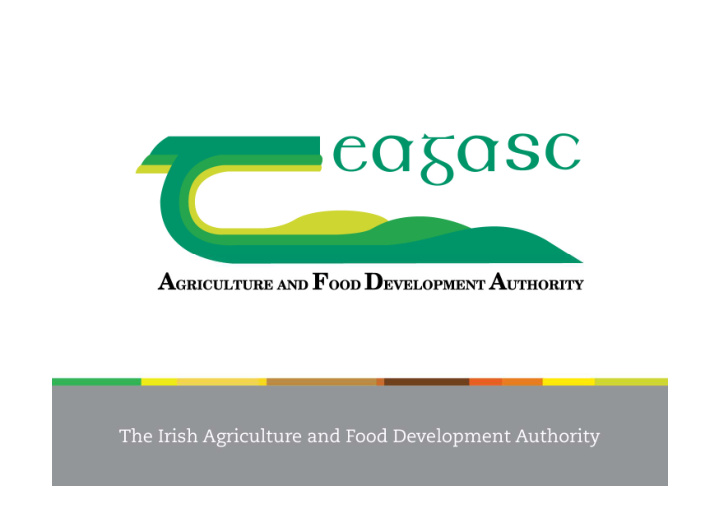



A framework for dairy growth: Teagasc supporting dairy farmers Dr. Tom O’Dwyer Head of Dairy Knowledge Transfer, Teagasc
Presentation Overview 1. Introduction 2. Key Advisory Messages 3. Adviser Numbers and Workload 4. Discussion Groups 5. Service Packages 6. Industry Support – Joint Programmes 7. The Future?
Teagasc model of knowledge delivery Research Advisory Education To support science-based innovation… so as to underpin profitability, competitiveness and sustainability
Key Performance Indicators for Resilient Systems Current Current Target Based on 2012 statistics Average Top 10% Pasture growth (t DM/ha) 6 - 8 10 - 16 12 - 20 Herd EBI ( € ) 100 140 >200 6 week herd calving rate (%) 55 70* 90 Grass utilisation (t DM/ha) 7.0* 9.0* 14.0 Milk solids (kg/ha) 665 850 1,400 Cows per labour unit (No./ Lb.U) 40 - 80 80 - 100 100 - 150 *estimates based on available information
Why is Grass Utilisation Important? 4000 3500 R 2 = 0.42 3000 Net profit ( € /ha) 2500 2000 1500 1000 500 0 0 2 4 6 8 10 12 14 16 Estimated Grass utilisation t DM/ha Each additional tonne of DM/ha is worth € 161/ha
Identifying the stocking rate for a resilient system Previous stocking rate studies have highlighted the biologically optimum SR Pasture grown, t t supplement DM/cow 10 12 14 16 1.7 2.1 2.4 2.8 0.25 1.8 2.2 2.5 3.0 0.50 1.9 2.3 2.7 3.1 0.75 2.0 2.4 2.9 3.2 1.00 2.1 2.5 3.0 3.4 1.25 *All of these stocking rates equate to 85 kg live weight/t feed DM available.
Agronomy: growing more higher quality feed Currently only 12% of dairy soil samples are of satisfactory status Correcting soil fertility could increase growth by 1.5 – 2.0 tDM/Ha/year Improving grazing practices could lift production by 1.0 tDM/Ha/year
Results – but … big variation between farms € 5,000 € 4,000 € 3,000 Net Margin ( € per ha) € 2,000 € 1,000 € 0 0% 10% 20% 30% 40% - € 1,000 - € 2,000 % Imported Feed
Recruiting the Resilient Dairy Cow The ‘Essential’ qualifications, skills and behaviors of a resilient dairy cow Essential Desirable Qualifications High EBI Feed efficient - suited to Results from Next Feb/March calving higher SR systems Generation Herd show that Skills One calf per cow per year ‘Elite’ animals produce more 4 – 5 lactations milk solids and have better High MS production fertility . Easy care Behavioural Self motivated - ability to work as part of a larger team Competencies
Use of Key Dairy Technologies % Milk Recording 42 Use of Herd Plus 28 Use of AI 82 Use of dry cow therapy to reduce mastitis 98 Use of teat disinfection to reduce mastitis 90 Complete grass covers 17 Complete grass budgets 12 Regular soil testing 66 Use of cash flow budget 13 Use of e-profit monitor 26 Teagasc NFS dairy farms, 2009
The Teagasc Farm Business Monitoring System
Adviser Numbers and Workload Dairy Adviser Workload •150 clients •4 – 5 groups •40 ePM; 10 Bus. Plans •30 Derogation Plans (‘out-sourced’) •150 BPS •1 – 2 public events •YFS, TAMS, CC •Client support
Discussion Groups Established New Non- members members members Technical Performance Indicator Milk solids per cow: ≥ 378kg 53 49 37 Somatic Cell Count: ≤ 200,000 cells/ml 52 55 23 Concentrate feed per cow: ≤ 750kg per cow 57 41 39 Financial Performance Net Margin ( € per litre) 0.145 0.121 0.116 Net Margin per hectare ( € ) 1,516 1,234 1,050 Source: National Farm Survey, 2011
Service Packages ‘ Technology ’ • Club package plus one visit or significant consultation • € 215 – 340 depending on farm size ‘Technology + Group’ • Adds annual group membership fee • € 150 ‘Farm Plan’ • Adds one visit plus farm plan preparation • € 450 ‘Gold’ • Intensive service - 6 x visits or significant consultations • € 1,300
Industry Support: Joint Programmes and collaborations
The Future Teagasc will • champion ‘sustainable expansion’ establish a new Dairy Expansion Service • prioritise education and dairy Advisory Service • • work towards ‘out-sourcing’ non-core work seek to leverage existing Joint Programmes and • develop new ones provide an independent, research backed • Advisory Service at a reasonable cost
Recommend
More recommend